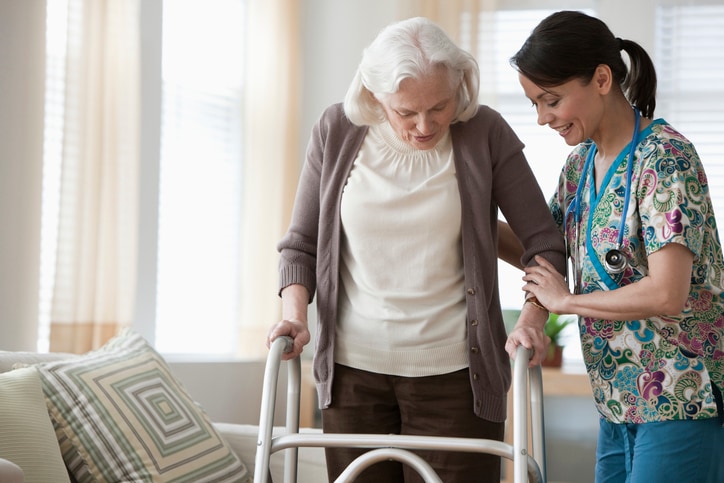In this article
Incontinence happens to people of all ages and who have a diverse range of conditions, but it’s an especially common concern for older adults. The condition shows up for a number of reasons throughout our lifespans — yet it’s rarely discussed, having been deemed too private or too embarrassing. But this lack of discussion prevents the normalization of a truth: For many people, incontinence care is a part of life.
“Incontinence means that there are issues controlling urine and/or stool,” says Daniel M. Pierce, associate clinical professor at the University of New England College of Osteopathic Medicine. “This can be caused by multiple reasons and can be anywhere from occasional and mild to more severe, interfering with day-to-day activities.”
Individuals experiencing incontinence might deal with shame, stigma and loneliness as a consequence. Seniors, in particular, are left to find solutions as they process the loneliness of aging and relearning the dynamics of a once-familiar body. Thankfully, there are existing channels where aging people and their loved ones can find support. Here’s what to know about incontinence care.
What is incontinence care?
incontinent carewhat is incontinence care refers to the management and support provided to individuals with difficulty controlling their bladder or bowel movements, says Aleece Fosnight a board-certified physician assistant and medical advisor at Aeroflow Urology. This care involves a range of practices and products used to maintain hygiene, dignity, comfort and overall health for those affected.
Pierce notes that incontinence care would be whatever is necessary to maximize independence and the instrumental activities of daily living (ADLs). “Care needs for older adults versus others would simply depend on the level of independence these individuals possess, including the ability to obtain needed supplies, as well as the ability to use the needed supplies independently,” he explains.
While urinary incontinence is common, it is not normal, Fosnight adds. People dealing with incontinence can and should seek assistance from a health care provider.
What causes elderly incontinence?
Many conditions and health needs can cause incontinence. For older adults, Fosnight says common causes are conditions that cause muscle weakness and deficient hormone levels, as well as neurological conditions like multiple sclerosis, Parkinson’s dementia, stroke or spinal cord injury.
Other conditions that can contribute to incontinence include:
- Prostate concerns, such as enlarged prostate or cancer.
- Diabetes.
- Chronic bronchitis, emphysema and asthma.
- Interstitial cystitis, a bladder condition.
- Recurrent urinary tract infections.
- Pelvic organ prolapse, surgery or radiation.
- Dementia and Alzheimer’s.
- Diuretic medications.
- Smoking.
- High fluid intake.
- Constipation.
Key signs of incontinence
If an aging adult is dealing with frequent urination, sudden incontinence, involuntary leaking, painful urination or nighttime urination, it’s a sign it may be time for incontinence care.
Individuals experiencing incontinence may have different struggles. Fosnight says the following are common symptoms:
- Increased urinary frequency or urgency.
- Leaking during physical activity.
- Incomplete bladder emptying.
- Slow or weak urinary stream.
- Nighttime urination and/or bedwetting.
- frequent urinary tract infections,
- Leakage during sexual activity.
- Constipation or fecal incontinence.
How to deal with elderly incontinence: Options for care
Seniors living with incontinence may have care needs that differ in several ways, says Nicole Brackett, director of quality and care delivery with Homewatch CareGivers. This might include unique challenges regarding hygiene, mobility, emotional well-being and dignity.
Here are the options to consider when incontinent care becomes a must.
Primary care doctors
A primary care doctor is a great initial point of contact to get help with elderly incontinence. “A person’s health care provider may prescribe lifestyle changes, medication or a procedure, along with management of whatever is causing the incontinence,” Brackett explains.
Fosnight says primary care providers should initiate the conversation and refer you to a specialist. This might include one or more of the following:
- Urologist.
- Gynecologist.
- Pelvic floor therapist.
In-home care providers
Find a home care aide.
In-home care providers, such as a home health aide or skilled nurse, can provide incontinence care. “Home care agencies provide services like companionship, medication reminders, light housekeeping and personal care, such as assistance with bathing and dressing and other activities of daily living,” Brackett says.
“Seniors aging at home [can] benefit from tailored care plans that are customized to their unique needs,” she adds. “The care can be delivered on a flexible schedule, allowing seniors to maintain a greater sense of independence.”
Read more:
Nursing home care
When incontinence issues overlap with other health concerns, it could also be time to consider a nursing home, where residents have access to round-the-clock care.
“This is essential for those with more complex medical or physical needs who cannot sufficiently be supported in the home,” Brackett says. “Nurses and medical professionals are always available, which is a significant benefit for individuals with serious health conditions or who require constant monitoring.”
Other care options
Seniors living with incontinence can find various resources to help them manage the condition. “One resource is their local area agency on aging (AAA) that will connect seniors with community resources to include incontinent supplies, support groups and home care services,” says Brackett.
Brackett also notes that local agencies and organizations like Homewatch Caregivers can connect clients with the resources to make incontinence care as manageable and dignified as possible, often collaborating with other health care providers to develop a customized care plan.
A pelvic floor therapist can also be essential to help determine pelvic floor disorders causing urinary incontinence,” he says, noting the importance of mental health therapists in supporting the patient with emotional well-being through this process.
“By providing comprehensive education to caregivers and families and encouraging open conversations about incontinence, we can help normalize the experience and reduce feelings of shame or embarrassment.”
— Nicole Brackett, director, Homewatch CareGivers
Managing the social and emotional impact of incontinence care
Brackett notes that social stigma and a lack of open discussion make it even more challenging for seniors who require incontinence care. “Seniors may feel embarrassed about needing assistance with this type of care, which is highly personal,” she explains. “This can affect their sense of dignity and [create] hesitation to accept care, even from a family member.”
Fosnight notes that in addition to the physical symptoms, incontinence can also contribute to:
- Embarrassment and shame.
- Increased desire for isolation.
- Decreased self-confidence or self-esteem.
- Reduced quality of life
- Stress and frustration.
For caregivers, education plays an important role in reducing the stigma surrounding incontinence care for seniors, the experts note. “By providing comprehensive education to caregivers and families and encouraging open conversations about incontinence, we can help normalize the experience and reduce feelings of shame or embarrassment,” Brackett says.
The bottom line
Incontinence doesn’t discriminate; however, adults and seniors experiencing this common yet disruptive issue might require more tailored support. Whether the issue is caused by age, neurological issues or prior pelvic-related concerns, solutions must be responsive to the needs of the individual and be anchored in respectful and shame-free solutions.
It’s important for caregivers to balance sensitivity, respect and practical care when supporting seniors with incontinence. “The priority is to meet the physical needs… but also ensure they maintain their dignity and are supported,” Brackett concludes.





